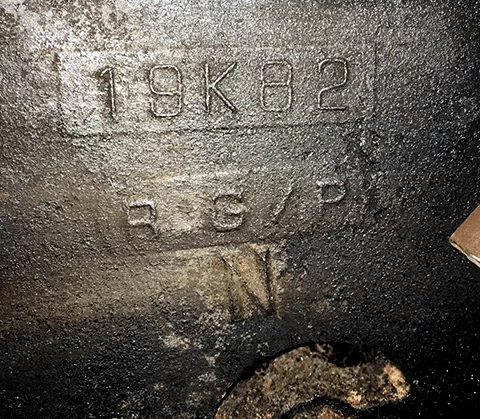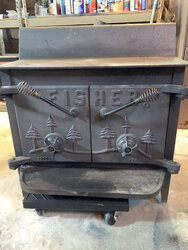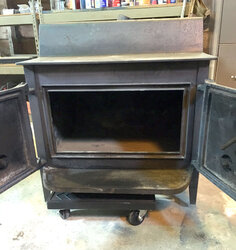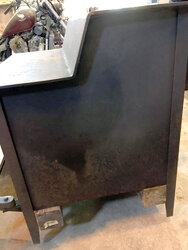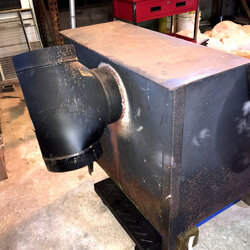Info needed about my Grandpa Bear
- Thread starter ellisc
- Start date
-
Active since 1995, Hearth.com is THE place on the internet for free information and advice about wood stoves, pellet stoves and other energy saving equipment.
We strive to provide opinions, articles, discussions and history related to Hearth Products and in a more general sense, energy issues.
We promote the EFFICIENT, RESPONSIBLE, CLEAN and SAFE use of all fuels, whether renewable or fossil.
You are using an out of date browser. It may not display this or other websites correctly.
You should upgrade or use an alternative browser.
You should upgrade or use an alternative browser.
Markings on doors are foundry markings for doors only. All fabricators had to buy doors from Fisher so they could keep track of royalties owed. Doors were shipped to fabricators so that won't give you any info on the stove body or finishing (hanging doors, ash fender and cutting vent as needed when sold). Pictures of your stove will show progress of changes such as the type of doors, air dampers, door handle bends, spring handles, too many details to mention. Is the outlet pipe on the back or top? baffle or shields, is the outlet pipe welded inside or out?
Markings on doors are foundry markings for doors only. All fabricators had to buy doors from Fisher so they could keep track of royalties owed. Doors were shipped to fabricators so that won't give you any info on the stove body or finishing (hanging doors, ash fender and cutting vent as needed when sold). Pictures of your stove will show progress of changes such as the type of doors, air dampers, door handle bends, spring handles, too many details to mention. Is the outlet pipe on the back or top? baffle or shields, is the outlet pipe welded inside or out?
Thanks for the response. No baffles or shields. Outlet pipe is on the back (I'll have to look again to check the weld). I've seen brick layout diagrams for some of the other series, but do you have one for the grandpa? I removed all of the bricks and pieces over the weekend and will need to replace with new ones.
I need a front picture to give you the correct brick layout. Not only did they make Grandpa I,II, and III, they continued to make the old style box with angle iron legs ($100 cheaper for installation for non-combustible surface and walls) along with the one piece box. Without shields and baffle yours sounds like the cheaper un-listed version. I'm not going to guess since there were many variations when customers would specify what they wanted and divert from drawings.
'77 or '78. (The 19K82 is not a year marking, only arched top doors were made after 1979) No baffle in the old style box, but the white paint around exhaust shows extreme heat where one is needed. Make sure there are no stress cracks on the back around the pipe.
https://www.hearth.com/talk/threads...less-smoke-under-25.74710/page-6#post-2139844
Firebrick layout here;
https://www.hearth.com/talk/threads/grandpa-bear-firebricks.117985/
https://www.hearth.com/talk/threads...less-smoke-under-25.74710/page-6#post-2139844
Firebrick layout here;
https://www.hearth.com/talk/threads/grandpa-bear-firebricks.117985/
Great info about the baffle coaly, thank you. Would an adapter/damper like the following link be of any use?
http://www.woodlanddirect.com/Chimney/Double-Wall-Black-Stove-Pipe/Adapter-Damper-Section
http://www.woodlanddirect.com/Chimney/Double-Wall-Black-Stove-Pipe/Adapter-Damper-Section
Last edited:
A flue damper is for the chimney, not the stove.
That pipe section is for double wall pipe. Normally single wall is used unless closer than 18 inches to combustible. Double wall pipe can be used down to 6 inch. There are other reasons for using double wall pipe when higher flue gas temperatures are required to keep chimney flue above the condensing point of 250* f while smoke is present. Condensing water vapor in exhaust allows smoke particle to stick allowing rapid creosote build up. This can become critical with high ceilings that cool single wall pipe too much decreasing inner flue temperature. Large chimney flue diameter and height requires more heat to stay above the critical 250* to the top as well, so double wall is more efficient, but the cost is not always worth it. Depends on the installation.
As far as damper, yes one is required on the double door stoves. Normally installed in first section of straight pipe or anywhere easily accessible. In Fireplace Mode with screen in place, the damper becomes the only control to slow the fire. Close damper slowly until smoke forms and begins to roll in at top of door opening. Open slightly to allow smoke to rise retaining as much heat as possible. It is not considered a radiant heater in Fireplace Mode.
A flue damper is a variable resistance that slows flue gas velocity effecting how much air enters the stove. When learning, err on the side of leaving it open. It's better to waste some heat up the chimney than to form creosote. You will learn how much heat your chimney requires by creosote formation. Large inefficient chimneys that require tons of heat need it more open. Same as adding a baffle inside stove, you can then run more open since you have more internal resistance through the firebox and less heat available lost up the stack.
Damper setting depends on chimney heat requirements, so no one can tell you where to run it until you have a pipe thermometer on the connector pipe. You will learn from experience and creosote formation. Weather, (temperature and atmospheric air pressure) chimney construction, even fuel changes damper settings.
That pipe section is for double wall pipe. Normally single wall is used unless closer than 18 inches to combustible. Double wall pipe can be used down to 6 inch. There are other reasons for using double wall pipe when higher flue gas temperatures are required to keep chimney flue above the condensing point of 250* f while smoke is present. Condensing water vapor in exhaust allows smoke particle to stick allowing rapid creosote build up. This can become critical with high ceilings that cool single wall pipe too much decreasing inner flue temperature. Large chimney flue diameter and height requires more heat to stay above the critical 250* to the top as well, so double wall is more efficient, but the cost is not always worth it. Depends on the installation.
As far as damper, yes one is required on the double door stoves. Normally installed in first section of straight pipe or anywhere easily accessible. In Fireplace Mode with screen in place, the damper becomes the only control to slow the fire. Close damper slowly until smoke forms and begins to roll in at top of door opening. Open slightly to allow smoke to rise retaining as much heat as possible. It is not considered a radiant heater in Fireplace Mode.
A flue damper is a variable resistance that slows flue gas velocity effecting how much air enters the stove. When learning, err on the side of leaving it open. It's better to waste some heat up the chimney than to form creosote. You will learn how much heat your chimney requires by creosote formation. Large inefficient chimneys that require tons of heat need it more open. Same as adding a baffle inside stove, you can then run more open since you have more internal resistance through the firebox and less heat available lost up the stack.
Damper setting depends on chimney heat requirements, so no one can tell you where to run it until you have a pipe thermometer on the connector pipe. You will learn from experience and creosote formation. Weather, (temperature and atmospheric air pressure) chimney construction, even fuel changes damper settings.
A flue damper is for the chimney, not the stove.
That pipe section is for double wall pipe. Normally single wall is used unless closer than 18 inches to combustible. Double wall pipe can be used down to 6 inch. There are other reasons for using double wall pipe when higher flue gas temperatures are required to keep chimney flue above the condensing point of 250* f while smoke is present. Condensing water vapor in exhaust allows smoke particle to stick allowing rapid creosote build up. This can become critical with high ceilings that cool single wall pipe too much decreasing inner flue temperature. Large chimney flue diameter and height requires more heat to stay above the critical 250* to the top as well, so double wall is more efficient, but the cost is not always worth it. Depends on the installation.
As far as damper, yes one is required on the double door stoves. Normally installed in first section of straight pipe or anywhere easily accessible. In Fireplace Mode with screen in place, the damper becomes the only control to slow the fire. Close damper slowly until smoke forms and begins to roll in at top of door opening. Open slightly to allow smoke to rise retaining as much heat as possible. It is not considered a radiant heater in Fireplace Mode.
A flue damper is a variable resistance that slows flue gas velocity effecting how much air enters the stove. When learning, err on the side of leaving it open. It's better to waste some heat up the chimney than to form creosote. You will learn how much heat your chimney requires by creosote formation. Large inefficient chimneys that require tons of heat need it more open. Same as adding a baffle inside stove, you can then run more open since you have more internal resistance through the firebox and less heat available lost up the stack.
Damper setting depends on chimney heat requirements, so no one can tell you where to run it until you have a pipe thermometer on the connector pipe. You will learn from experience and creosote formation. Weather, (temperature and atmospheric air pressure) chimney construction, even fuel changes damper settings.
Great info. Thank you!
Similar threads
- Replies
- 5
- Views
- 1K
- Replies
- 6
- Views
- 2K
- Replies
- 1
- Views
- 864
- Replies
- 8
- Views
- 2K


